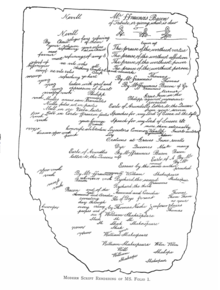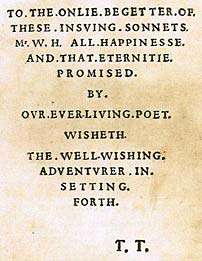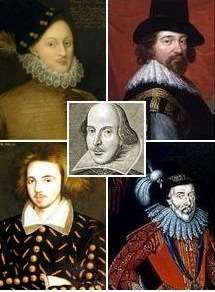Nevillean theory of Shakespeare authorship
The Nevillean theory of Shakespeare authorship contends that the English parliamentarian and diplomat Sir Henry Neville (bap. 1564–1615), wrote the plays and poems traditionally attributed to William Shakespeare.
%2C_circle_of_George_Gower.jpg)
First proposed in 2005, the theory relies upon perceived correspondences between aspects of Neville's life and the circumstances surrounding and contents of Shakespeare's works, interpretative readings of manuscripts purportedly connected with Neville, cryptographic ciphers and codes in the dedication to Shakespeare's Sonnets, and other perceived links between Neville and Shakespeare’s works. In addition, a conspiracy is posited in which Ben Jonson attributed the First Folio to William Shakespeare in order to hide Neville’s authorship.
The convergence of documentary evidence of the type used by academics for authorial attribution – title pages, testimony by contemporary poets and historians, and official records – sufficiently establishes Shakespeare's authorship for the overwhelming majority of Shakespeare scholars and literary historians, and no such evidence links Neville to Shakespeare's works. They reject all alternative authorship candidates, including Neville. The few that have responded to Nevillean claims have overwhelmingly dismissed the theory. They say the theory has no credible evidence, relies upon factual errors and distortions, and ignores contrary evidence.
Description
The basis of the Nevillean theory is that William Shakespeare of Stratford-upon-Avon was not the real author of the works traditionally attributed to him, but instead a front to conceal the true author, Henry Neville.[1] In their attempt to establish this, author Brenda James, historian William Rubinstein and author John Casson cite many of the same arguments proposed by other anti-Stratfodian theories. The theory suggests that these four main elements, when taken together, reveal that Neville was the hidden author behind the works:
- Biographical details, including his lifespan in relation to Shakespeare, access to known sources of Shakespeare's works, affiliation with people connected to the works of Shakesepare, and biographical coincidences with events described in Shakespeare’s plays and poems
- A conspiracy in which Ben Jonson was complicit in hiding Neville's identity as the true author
- An interpretative reading of the Northumberland Manuscript and a manuscript known as the Tower Notebook
- A cipher message hidden in the dedication of Shakespeare's Sonnets
Arguments from biography
The theory proposes that many aspects of Neville's biography may be seen as relevant, most fundamentally that Neville's dates (1562–1615) are similar to Shakespeare's (1564–1616).[2][3]
Shakespeare's poems Venus and Adonis (1593) and The Rape of Lucrece (1594) bear dedications to Henry Wriothesley, 3rd Earl of Southampton signed by "William Shakespeare". James and Rubinstein assert that there is "no evidence" Southampton was Shakespeare's patron, that the dedication was written by Neville as a "joke", and that Southampton and Neville were friends in the 1590s. Kathman writes that the existence of the dedication is itself evidence of Southampton's patronage of Shakespeare, that James and Rubinstein "dismiss" Neville's explicit 1601 testimony that he had not spoken to Southampton between his childhood and the abortive 1601 Essex Rebellion, and that Neville and Southampton's friendship is only documented from 1603 onward.[4]
James and Rubinstein argue that "Neville's experiences, such as travel on the Continent and imprisonment in the Tower, correspond with uncanny exactness to the materials of the plays and their order."[5]
James and Rubinstein advance their argument by what MacDonald P. Jackson calls "tracing improbable connections between Shakespeare's works and Neville's busy public life". For instance, they suggest that the French language dialogue in Henry V, written in 1599, coincides with Neville's experience as ambassador to France (1599-1601). They also propose that the use of certain Italian words in the plays shows that their author must have been in Italy, as Neville was. Jackson writes that Shakespeare could have derived the dialogue in Henry V from a phrasebook and could have learned about Italy from guidebooks and from Italians in London.[6]
Conspiracy

As with many other anti-Stratfordian theories, the Nevillean theory holds that Ben Jonson conspired to conceal the true author of Shakespeare's works.[8] James and Rubinstein assert that a conspiracy "must have occurred" and that John Heminges and Henry Condell, who helped prepare the first printed edition of Shakespeare's plays, were in on it.[9]
James and Rubinstein also cite the famous phrase "Sweet Swan of Avon" Jonson uses in his poem prefacing the First Folio. They suggest that since "native swans in Britain are mute" this is a subtle hint from Jonson that Shakespeare was not a "true writer".[10] As motive for the conspiracy, the Nevilleans argue that a man with Neville's status would not want to have been known as a playwright.[11]
MacDonald P. Jackson writes that since there are also two dozen contemporaneous written accounts of Shakespeare as a playwright, for the conspiracy to be real all these accounts must be the work of "liars or dupes".[12] Matt Kubus writes that for the conspiracy to work, all of Shakespeare's many known collaborators would have had to have known he was a front man, and kept silent. Kubus says this is hard to believe.[13]

Arguments from documentary evidence
In addition to the circumstances of Neville's life, the theory adduces several pieces of documentary evidence.
Chief among these is the so-called "Tower Notebook", a 196 page manuscript of 1602 that details royal protocols, and which James and Rubinstein assert is "unquestionably" the work of Neville, despite it not bearing Neville's name or containing any text in his handwriting. One page of the notebook contains descriptions of protocols for the coronation of Anne Boleyn which are similar to stage directions in Henry VIII, a play Shakespeare co-wrote with John Fletcher. The scholarly consensus is that the scene in question was written by Fletcher.[14]
A further argument is based on handwritten annotations in a 1550 edition of the book Union of the Two Noble and Illustre Families of Lancashire and York by Edward Hall. The annotations had previously been speculated to be in Shakespeare's hand, and been the subject of some academic debate since the 1950s. Because another book with the same library mark bore the name "Worsley", and because "Worsley" is a name within the Neville family, James and Rubinstein assert that the handwritten annotations must be Neville's.[15]
Another document produced in evidence is the front cover of the Northumberland Manuscript. This tattered piece of paper contains many words and handwritten names of figures of the age, including Shakespeare's, Francis Bacon's, and "the word 'Nevill' followed by the punning Latin family motto 'ne vile velis' (desire nothing base)". Although there is no evidence Neville had any involvement with the document, James and Rubinstein argue that he is its author, and that it is evidence he "practised Shakespeare's signature." The page has also been used by Baconians as supposed evidence for Bacon being the true author of Shakespeare's works.[16]
John Casson, author of the 2016 book Sir Henry Neville Was Shakespeare: The Evidence, also argues for the Neville theory. Casson discovered in the British Library an annotated copy of François de Belleforest’s Histoires Tragiques (1576), a French translation considered a possible source of Hamlet.[17] Casson believes it likely the annotations are Shakespeare's, and that they strengthen the case for Neville being Shakespeare, since Neville knew French and books at Audley End contain handwriting which has a letterform which appears similar.[18]
Code theory

The Truth Will Out references a cipher in the dedication to Shakespeare's Sonnets in a long endnote.[19] In a 2008 monograph entitled Henry Neville and the Shakespeare Code, Brenda James sets out how she revealed Neville's name by laying the letters on a grid and performing manipulations. Matt Kubus challenged James's code theory as "peppered with assumptions", suggesting that it undermined the other arguments in The Truth Will Out, and that "it is difficult to relate James's argument without appearing derisive".[20]
Related Research
Casson argues in his 2009 book Enter Pursued by a Bear that Neville wrote the Phaeton sonnet in a book by John Florio, and that Neville-as-Shakespeare also contributed to several plays in the Shakespeare apocrypha.[21] English literature professor Brean Hammond writes that in Bear, Casson "argues that Double Falsehood is indeed the lost Cardenio -- that Shakespeare's hand is certainly in it". Casson uses an idea proposed by Ted Hughes for identifying telltale patterns of imagery that modulate throughout Shakespeare's oeuvre. Hammond finds the approach "not convincing". Hammond writes that Casson's claims of telling connections between Neville, Fletcher, and Spain suffer from "a degree of" fluellenism – the imparting of non-existent significance to mere coincidences. However, Hammond suggests that Casson provides valuable material that warrants further study.[22]
There was a dedicated Journal of Neville Studies.[23]
History and Reception
The theory of Nevillean authorship was first proposed by Brenda James who had drafted an entire book before meeting its eventual co-author, historian William D. Rubinstein. Their book was published in 2005 entitled The Truth Will Out: Unmasking the Real Shakespeare.[24]
At the time of the launch of The Truth Will Out Jonathan Bate said there was "not the slightest shred of evidence" to support its contentions.[25] MacDonald P. Jackson wrote in a book review of The Truth Will Out that "it would take a book to explain all that is wrong".[26] Reviewing the 2007 American edition of The Truth Will Out in the Shakespeare Quarterly, David Kathman wrote that despite its bold claims, "the promised 'evidence' is non-existent or very flimsy," and that the book is "a train wreck" filled with "factual errors, distortions, and arguments that are incoherent" as well as "pseudoscholarly inanities".[27]
Robert Pringle rejected Neville's authorship, explaining that "Shakespeare received a thoroughly good classical education at the Stratford grammar school and then, for well over 20 years, was involved in artistic and intellectual circles in London."[28] Brian Vickers also rejects the Neville theory, similarly arguing that "Elizabethan grammar school was an intense crash course in reading and writing Latin verse, prose, and plays – the bigger schools often acted plays by Terence in the original."[29]
In answer to the negative reception the book received, editions following the first English one carry an afterword from Brenda James complaining about what she describes as a lack of "informed academic response".[30]
Notes
- Kathman 2007, p 245.
- Alberge 2005.
- Casson, Rubinstein & Ewald (2010), p. 114.
- Kathman 2007, p 246.
- Craig 2012, p 16-7.
- Jackson, p. 39.
- Walsh 2006, p. 125.
- Walsh 2006, p. 125.
- Kathman 2007, p. 246; Jackson, p. 40.
- Kubus 2013, p. 69.
- Casson, Rubinstein & Ewald (2010), p. 130.
- Jackson 2005, p. 40
- Kubus 2013, p. 68.
- Kathman 2007, pp. 246-247.
- Kathman 2007, p. 247.
- Jackson 2005, p. 39; Kathman 2007, p. 247.
- Flood 2018; The Telegraph 2009.
- Flood 2018.
- Kathman 2007, p. 245.
- Kubus 2013, pp. 54-56.
- The Telegraph 2009; Hammond 2012, pp. 67-68.
- Hammond 2012, pp. 67-68.
- Hammond 2012, pp. 67-68.
- Kathman 2007, p 245.
- BBC News 2005.
- Jackson 2005, p. 39.
- Kathman 2007, pp. 245, 248.
- Wiant 2005
- Flood 2018
- Walsh 2006, p. 125; Hammond 2012, pp. 67-68.
References
- Alberge, Dalya (5 October 2005). "Now Falstaff gets the role of man who wrote Shakespeare". The Times. Retrieved 3 January 2020.
- BBC News (5 October 2005). "Diplomat 'was real Shakespeare'".
- Casson, John; Rubinstein, William D. & Ewald, David (2010). "Chapter 5: Our Shakespeare: Hentry Neville 1562–1615". In Leahy, William (ed.). Shakespeare and His Authors: Critical Perspectives on the Authorship. Continuum. pp. 113-138. ISBN 978-1-4411-4836-0.
- Casson, John (2016). "The Annotated Amleth: Belleforest in the British Library". British Library. Retrieved December 26, 2019.
- Craig, Hugh (2012). "Chapter 1: Authorship". In Kinney, Arthur (ed.). The Oxford Handbook of Shakespeare. Oxford University Press. pp. 16–17.
- Flood, Alison (5 March 2018). "Shakespeare himself may have annotated 'Hamlet' book, claims researcher". The Guardian. Retrieved December 26, 2019.
- Gore-Langton, Robert (29 December 2014). "The Campaign to Prove Shakespeare Didn't Exist". Newsweek. Retrieved 27 December 2019.
- Hammond, Brean (2012). "Chapter 3: After Arden". In Carnegie, David; Taylor, David (eds.). The Quest for Cardenio: Shakespeare, Fletcher, Cervantes, and the Lost Play. Oxford University Press. p. 67-8. ISBN 9780199641819.
- MacDonald P. Jackson (2005). "Stunning the literary world: Shakespeare as Stooge". Shakespeare Newsletter (Book Review). 55 (2): 35.
- James, B. & Rubinstein, W. (2005). The Truth Will Out: Unmasking the Real Shakespeare. Harlow, UK: Pearson Longman. ISBN 9780061847448.
- Kathman, David (2007). "The Truth Will Out: Unmasking the Real Shakespeare". Shakespeare Quarterly (Book Review). 58 (2): 245–248. doi:10.1353/shq.2007.0024.
- Kubus, Matt (2013). "The unusual suspects". In Paul Edmonson; Stanley Wells (eds.). Shakespeare Beyond Doubt. Cambridge University Press. p. 54–56. ISBN 9781107354937.
- The Telegraph (17 March 2009). "Academic 'discovers' six works by William Shakespeare". Retrieved December 27, 2019.
- Walsh, William D. (2006). "Art & Humanities". Library Journal (Book Reviews). 131 (20).
- Wiant, Jenn (19 October 2005). "Bard Bashing In Vogue". Associated Press. Retrieved 30 December 2019.
